2021-2022学年人教版英语八年级下册Unit 3 Could you please clean your room?- SectionA(共5课时)教案
文档属性
| 名称 | 2021-2022学年人教版英语八年级下册Unit 3 Could you please clean your room?- SectionA(共5课时)教案 | 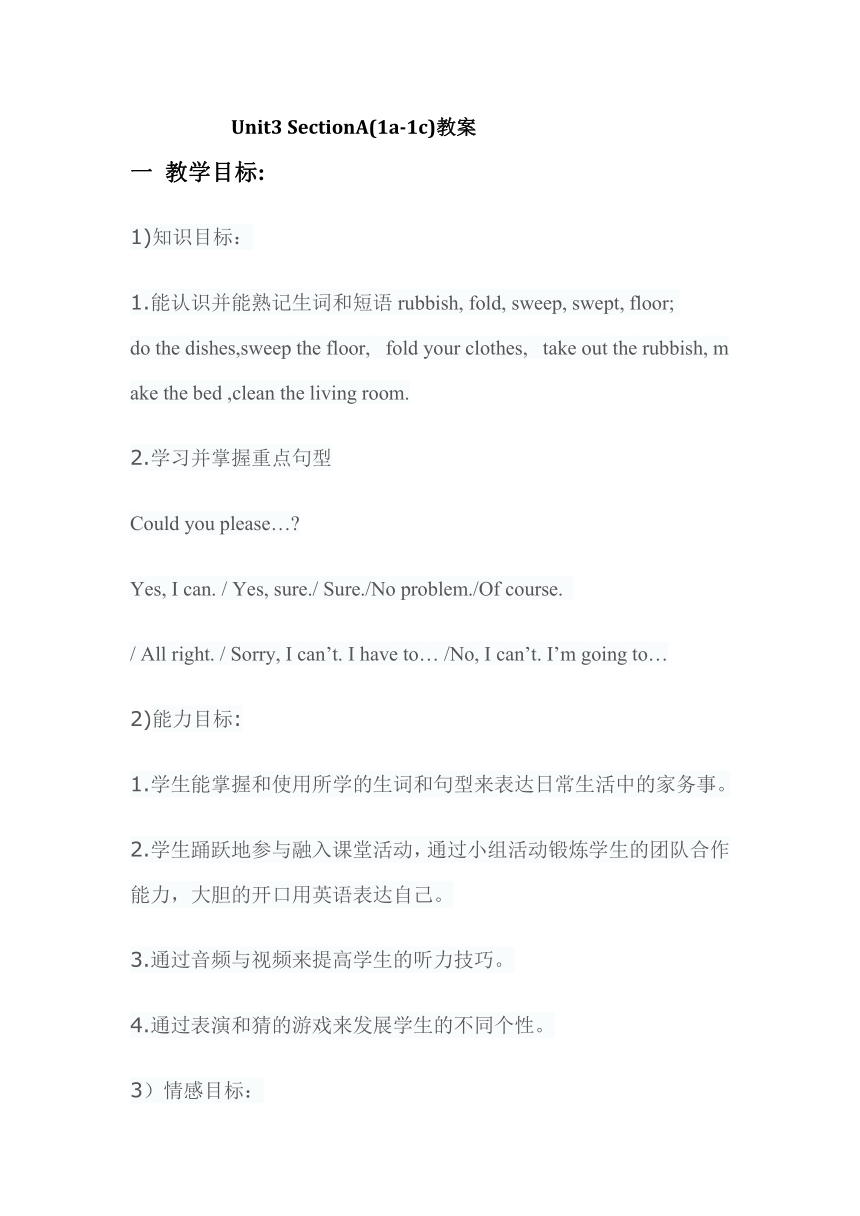 | |
| 格式 | zip | ||
| 文件大小 | 62.3KB | ||
| 资源类型 | 教案 | ||
| 版本资源 | 人教新目标(Go for it)版 | ||
| 科目 | 英语 | ||
| 更新时间 | 2022-02-28 14:17:13 | ||
图片预览

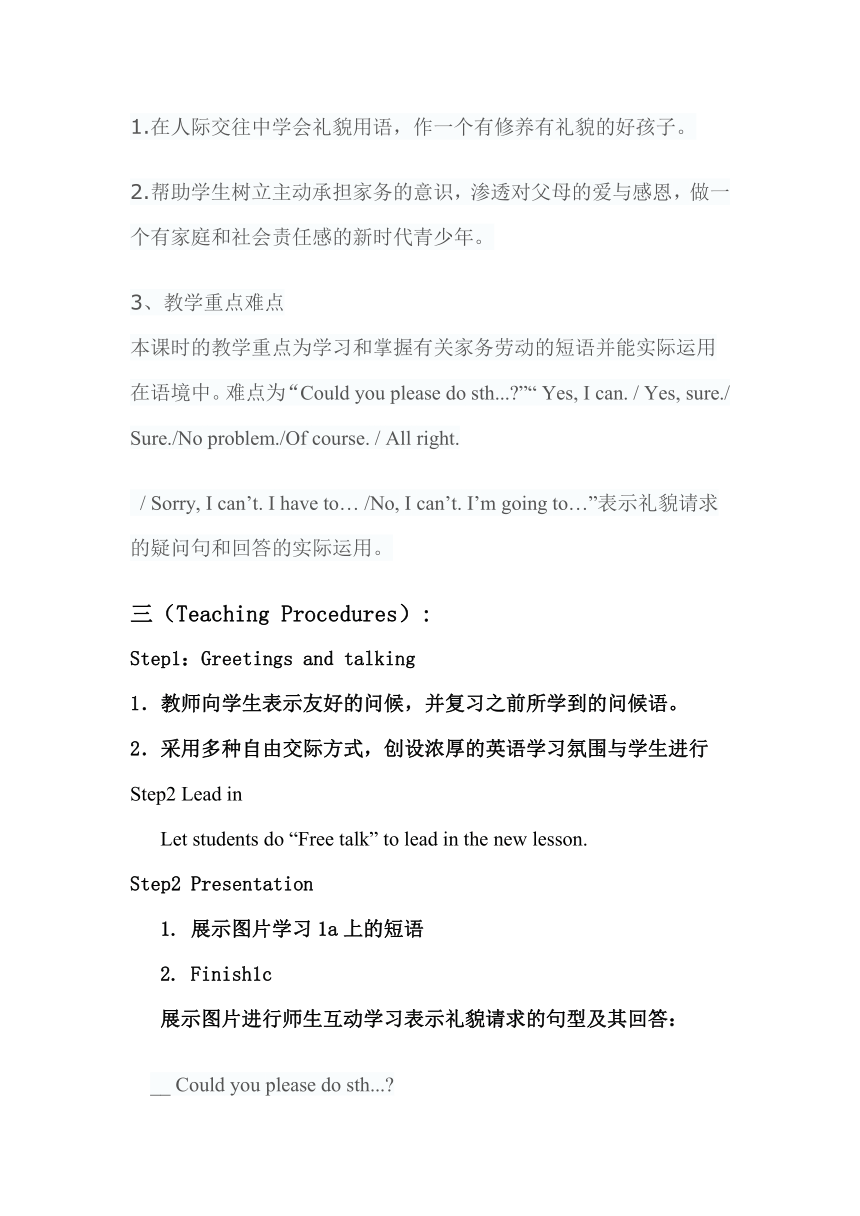
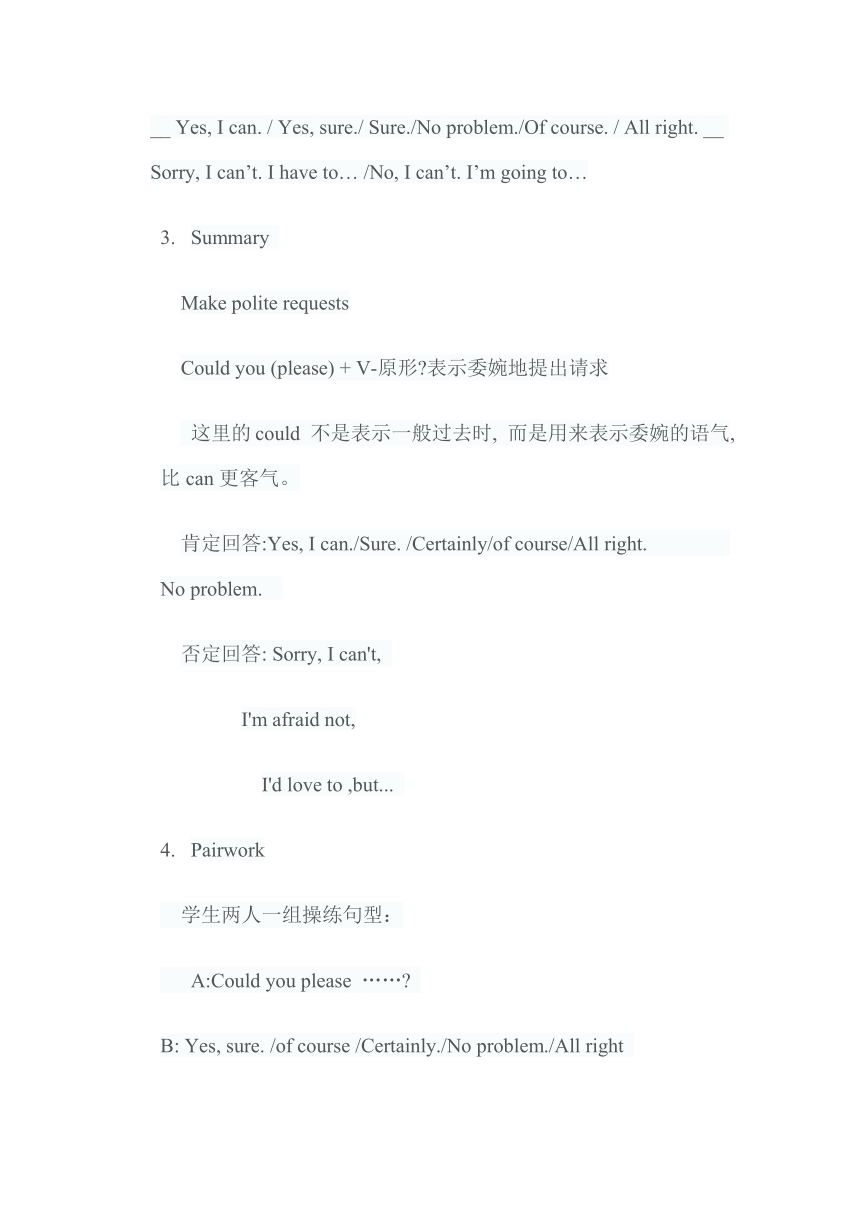
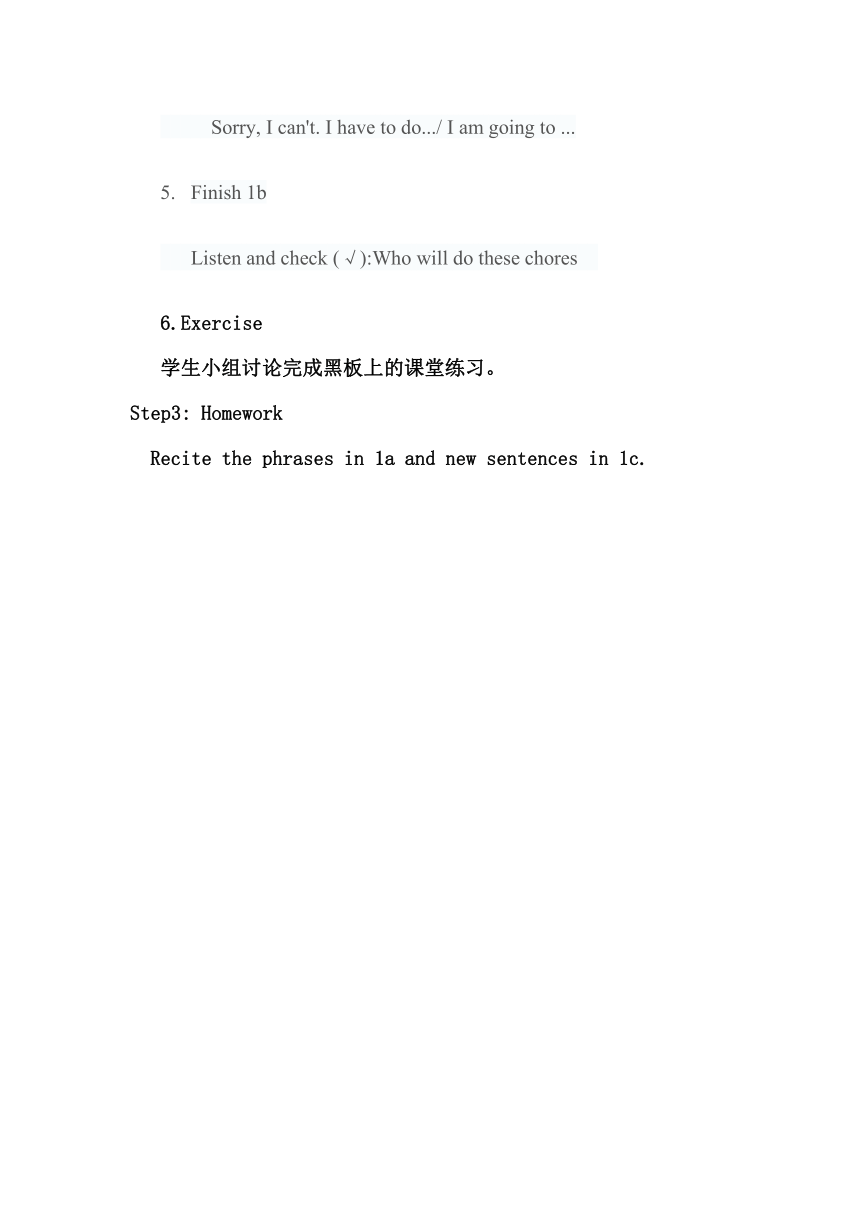
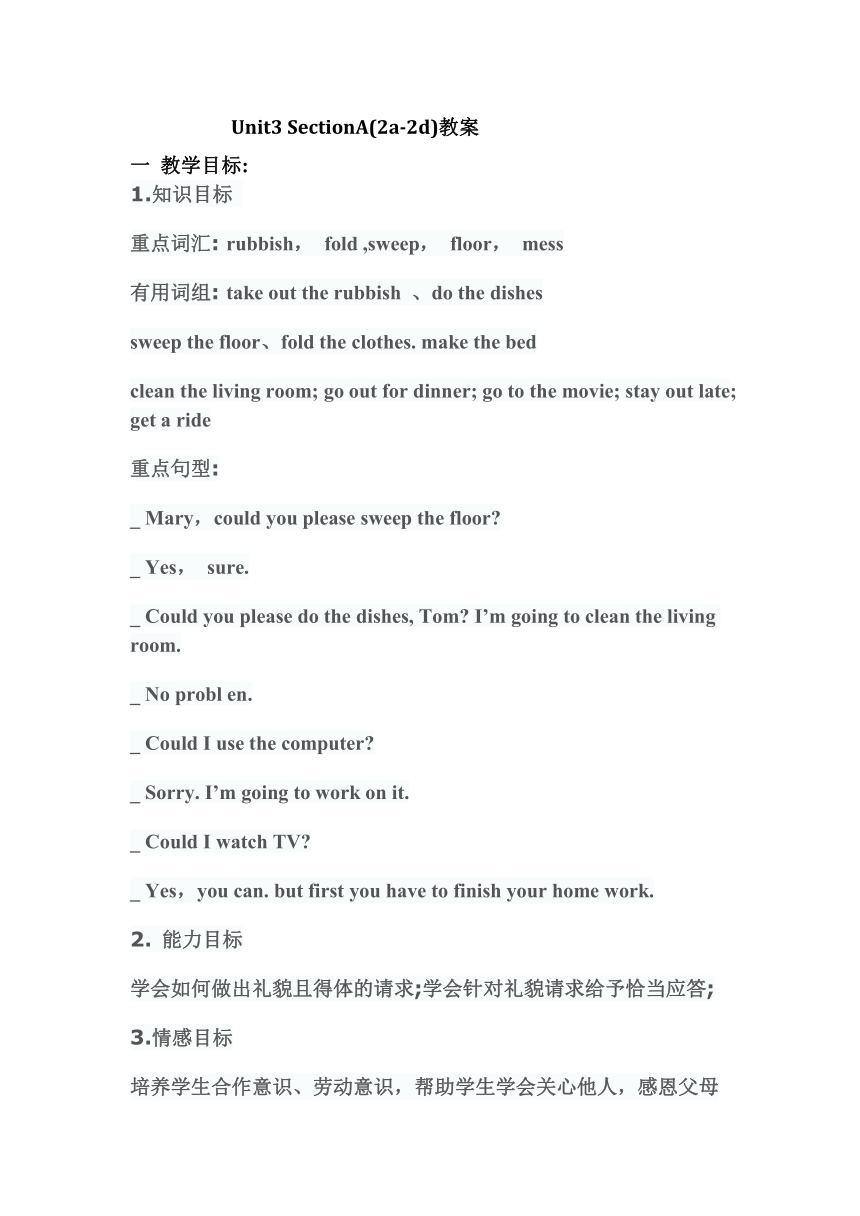
文档简介
Unit3 SectionA(1a-1c)教案
一 教学目标:
1)知识目标:
1.能认识并能熟记生词和短语rubbish, fold, sweep, swept, floor; do the dishes,sweep the floor, fold your clothes, take out the rubbish, make the bed ,clean the living room.
2.学习并掌握重点句型
Could you please…
Yes, I can. / Yes, sure./ Sure./No problem./Of course.
/ All right. / Sorry, I can’t. I have to… /No, I can’t. I’m going to…
能力目标:
1.学生能掌握和使用所学的生词和句型来表达日常生活中的家务事。
2.学生踊跃地参与融入课堂活动,通过小组活动锻炼学生的团队合作能力,大胆的开口用英语表达自己。
3.通过音频与视频来提高学生的听力技巧。
4.通过表演和猜的游戏来发展学生的不同个性。
3)情感目标:
1.在人际交往中学会礼貌用语,作一个有修养有礼貌的好孩子。
2.帮助学生树立主动承担家务的意识,渗透对父母的爱与感恩,做一个有家庭和社会责任感的新时代青少年。
3、教学重点难点
本课时的教学重点为学习和掌握有关家务劳动的短语并能实际运用在语境中。难点为“Could you please do sth... ”“ Yes, I can. / Yes, sure./ Sure./No problem./Of course. / All right.
/ Sorry, I can’t. I have to… /No, I can’t. I’m going to…”表示礼貌请求的疑问句和回答的实际运用。
三(Teaching Procedures):
Step1:Greetings and talking
1.教师向学生表示友好的问候,并复习之前所学到的问候语。
2.采用多种自由交际方式,创设浓厚的英语学习氛围与学生进行
Step2 Lead in
Let students do “Free talk” to lead in the new lesson.
Step2 Presentation
展示图片学习1a上的短语
Finish1c
展示图片进行师生互动学习表示礼貌请求的句型及其回答:
__ Could you please do sth...
__ Yes, I can. / Yes, sure./ Sure./No problem./Of course. / All right. __ Sorry, I can’t. I have to… /No, I can’t. I’m going to…
Summary
Make polite requests
Could you (please) + V-原形 表示委婉地提出请求
这里的could 不是表示一般过去时, 而是用来表示委婉的语气,比can更客气。
肯定回答:Yes, I can./Sure. /Certainly/of course/All right. No problem.
否定回答: Sorry, I can't,
I'm afraid not,
I'd love to ,but...
Pairwork
学生两人一组操练句型:
A:Could you please ……
B: Yes, sure. /of course /Certainly./No problem./All right
Sorry, I can't. I have to do.../ I am going to ...
Finish 1b
Listen and check (√):Who will do these chores
6.Exercise
学生小组讨论完成黑板上的课堂练习。
Step3: Homework
Recite the phrases in 1a and new sentences in 1c.
Unit3 SectionA(2a-2d)教案
一 教学目标:
1.知识目标
重点词汇: rubbish, fold ,sweep, floor, mess
有用词组: take out the rubbish 、do the dishes
sweep the floor、fold the clothes. make the bed
clean the living room; go out for dinner; go to the movie; stay out late; get a ride
重点句型:
_ Mary,could you please sweep the floor
_ Yes, sure.
_ Could you please do the dishes, Tom I’m going to clean the living room.
_ No probl en.
_ Could I use the computer
_ Sorry. I’m going to work on it.
_ Could I watch TV
_ Yes,you can. but first you have to finish your home work.
2. 能力目标
学会如何做出礼貌且得体的请求;学会针对礼貌请求给予恰当应答;
3.情感目标
培养学生合作意识、劳动意识,帮助学生学会关心他人,感恩父母
二、教学重难点
重点:掌握本课所有重点词汇和短语
难点:学会如何向他人做出礼貌且得体的请求并针对礼貌请求给予怡当应答
三(Teaching Procedures):
Step1:Greetings and talking
1.教师向学生表示友好的问候,并复习之前所学到的问候语。
2.采用多种自由交际方式,创设浓厚的英语学习氛围与学生进行
Step2 Review
展示图片进行师生互动复习上节课的短语和句型。
Step2 Presentation
1.展示图片进行师生互动学习表示礼貌请求的句型及其回答:
A: Could I ...
B: Yes, you can./ Sure./ No problem.
B: Sorry, you can’t. You have a ... tomorrow.
Pairwork
学生两人一组操练句型:
A: Could I ...
B: Yes, you can./ Sure./ No problem.
B: Sorry, you can’t. You have a ... tomorrow.
3.Summary
Make polite requests
Could you (please) + V-原形 表示委婉地提出请求
这里的could 不是表示一般过去时, 而是用来表示委婉的语气,比can更客气。
肯定回答:Yes, I can./Sure. /Certainly/of course/All right. No problem.
否定回答: Sorry, I can't, /I'm afraid not,/I'd love to ,but...
Finish 2a
Listen. Peter asks his father if he can do four things. What does his father say Check (√) yes or no.
Finish 2b
Listen again. Why does Peter’s father say “no” Draw lines to the reasons in the chart in 2a.
Finish 2d
Read 2d and answer questions on the Bb.
Listen to 2d and choose the right answers on the Bb.
6.Exercise
学生小组讨论完成黑板上的课堂练习
Step3: Homework
Recite the the sentences in 2c and 2d.
Unit3 SectionA(3a-3c)教案
一 教学目标:
知识与 技能
1)掌握本单元重点词汇与短语: throw. as soon as. shirt. neither did I. the minute (that)、a....as... 等。
2)学生能够熟读课文并能了解课文大意。
3)能够判断单词在句子中的词性,并运用不同的词性进行造句。
4)培养学生能够具有较好的阅读能力及口语表达能力。同时鼓励学生利用知识编造句子,
提高他们的的笔头运用能力。
过程与方法
本节课的阅读主要以问答形式进行解读,并用对话的形式操练及理解文章的大意。同时
通过句子理解重点词性,让学生通过词性并造句,达到学以致用。
情感态度价值观
培养学生爱劳动,分享家务的能力,并让其能够懂得要想拥有一个千净、舒适的家需要
我们和家人一起共同去分担家务。
[教学重点]
学生能够阅读文章并掌握重点词汇与短语。
[教学难点、关键]
学生能够辨别单词的词性,并造句。
[教学方法]
任务型语言教学法、情景交际法及归纳总结法。
三(Teaching Procedures):
Step1:Greetings and talking
1.教师向学生表示友好的问候,并复习之前所学到的问候语。
2.采用多种自由交际方式,创设浓厚的英语学习氛围与学生进行
Step2 Review
展示图片进行师生互动复习上节课的表示礼貌请求的句型及其回答:
A: Could I ...
B: Sure/ Yes, you can./ No problem/ Of course....
Sorry, you can’t. You have to... .
Step 2 Lead in
Let students do “Free talk”to lead in the new lesson.
Step2 Presentation
Finish 3a (Reading)
Pre-reading
Look at the picture and answer the questions on the Bb.
Fast-reading
(1) Let students read the passage quickly and answe a question “How many paragraphs are there in the article ”
(2)Divide the article into three parts and choose their right meanings.
(3)Careful-reading
Read part 1 and finish the tasks on the Bb.
Read Part 2 again and answer the following questions on the Bb.
Read part 3 and finish the task on the Bb.
Finish 3b
Read the sentences below.Underline the sentences from the reading that mean the same thing.
3.Language points
Finish 3c
Decide whether the underlined words in the sentences are verbs or nouns. Then write another sentence using theunderlined word in the other form.
4.Exercise
学生小组讨论完成黑板上的课堂练习
Step4: Homework
Do the exercise in the exercise book.
Unit 3 Could you please clean your room
Section A 3a—3c 读写课教学设计
一、教材分析
本课是新目标八年级下册第三单元Section A 的阅读部分,它的任务不仅仅是训练和提高阅读技能,也涵盖了实际交际、词汇和知识点等内容,同时它还承载着培养正确的情感态度、价值观等深层意义,培养学生分担家务的责任感。教学内容贴近学生生活,学生有一定的学习兴趣。
二、学情分析
本节课的授课对象为八年级的37名学生,大部分学生平时接触英语阅读材料的机会较少,学生通常是为了做题而阅读,所以调动学生阅读的积极性,使其在阅读过程中主动思考是本节课的重点。本节课的话题来自学生的生活经历,学生在人教版英语七年级下册Unit 4 Don’t eat in class. Section B 中已经学习了许多表示家务劳动的动词短语:do the dishes, help his mom make breakfast, clean his room等,为学生们的口语表达和书面表达提供了语言基础。
三、教学目标
1. 知识与技能:细读文章,学习相关的短语及表达,理解文章的含义,能复述课文内容。
(1) 短语:throw down, the minute / as soon as, come over, all the time, in surprise等。
(2) 句子:
a. The minute I sat down in front of the TV, my mom came over.
b. I’m just as tired as you are!
c. For one week, she did not do any housework and neither did I.
2. 过程与方法:熟练运用各种阅读技巧,如:推测、略读、寻读、细读、思维导图等方法,掌握全文内容。
3. 情感态度及价值观:要爱自己的父母,学会分担家务。
四、教学重难点
1. 教学重点:使用阅读技巧在文中找到关键的信息,并对信息进行整合。
2. 教学难点:能够准确地分清名词和动词,并掌握区别和使用方法并造句。
五、教学准备
multimedia, computer, blackboard
六、教学过程:
Step 1 Greeting and review
T: Good morning, class!
Ss: Good morning, Miss Chen!
T: Now please role-play or dub the conversation in 2d.
【设计意图】对子间以对话表演或配音形式背诵2d对话,复习有关家务的相关短语以及锻炼学生的口语表达能力。
Step 2 Lead-in and Pre-reading
Free talk: Who does the housework in your home Do you often help your mother with the housework What chores do you do at home
Show a picture to arouse interests for the text.
T: What will happen if no one does the housework in a home Let’s see what happened in Nancy’s home.
【设计意图】通过谁做家务的问题激发学生对文本的学习兴趣,并导入阅读文章的主题。
Step 3 While-reading
1. Scanning
指导学生利用寻读策略阅读3a文章,鼓励学生以最快的速度回答下列问题:
(1) When did this happen
(2) What did Nancy want to do
(3) Why was Nancy’s mom angry with her
(4) Did they solve the problem How
【设计意图】通过回答问题了解文章的细节以及培养学生的阅读速度。
2. Careful reading
引领学生细读文章,完成思维导图。
大屏幕展示Chicken soup: Labor is often the father of pleasure. 引导学生要爱父母,学会分担家务。
【设计意图】用思维导图总结整篇阅读文章,使学生对文章结构一目了然,同时引出“心灵鸡汤”,引导学生要爱父母,学会分担家务。
Step 4 Post-reading
1. 让学生仔细研读课文,在文中找出下列短语:throw down, the minute / as soon as, come over, take sb for a walk, all the time, all day / all evening, as… as…, shout back, walk away, in surprise, be angry with sb, solve the problem
2. 指导学生完成3b,在文中找出下列句子的同义句。
(1) Neither of us did any housework for a week.
(2) My mom came over as soon as I sat down in front of the TV.
(3) You’re tired, but I’m tired, too.
教师适时点拨:
(1) neither/nor+be动词/助动词/情态动词+主语“……也不”。这是一个倒装结构,表示前面的否定情况也同样适合后者。
so+be动词/助动词/情态动词+主语“……也是”,表示前面的肯定情况也同样适合后者。
e.g. I can’t swim and neither can he.
“neither of+名词复数/代词宾格”作主语时,谓语动词用单复数形式都可以。
e.g. Neither of the answers is/are right.
(2) the minute“一……就……”相当于as soon as,引导时间状语从句。
e.g. I’ll call you the minute / as soon as I get there.(主将从现)
(3) as… as…原级比较,否定形式:not as/so… as…
e.g. He doesn’t work as/so hard as his brother.
【设计意图】学习相关短语及表达,扫清课文难点,解决学生困惑,以便更好地掌握文章的细节内容。
Step 5 Group work
引领学生听录音跟读课文,模仿语音语调,并指导各学习小组分角色朗读课文。
【设计意图】模仿表演是学生能够学会自由地运用语言的基础和前提,同时也锻炼学生的口语能力。
Step 6 Summary
1. 归纳既可以做动词也可以做名词的词。
2. 完成课本P19 3c,判断画线单词的词性,并用其另一个词性造句。
【设计意图】总结本节课所学,知识归类成块,学习构词法——转化法,使学生掌握记忆单词的方法。
Step 7 Homework
1. Retell the text according to the mind-map.
2. Write their own mind-maps of the text.
【设计意图】根据思维导图复述课文,以及根据自己对文章的理解设计思维导图,对本篇文章进行总结,起到加深记忆和巩固的作用。
Unit3 SectionA(Grammar Focus-4c)教案
一 教学目标:
1语言目标:谈论做家务的词汇,及如何有礼貌的提出要求。
2技能目标:能听懂和谈论做家务的话题;能写出重点单词和重点句型。
3情感目标:培养学生爱劳动,分享家务的能力。
教学重点
短语: do the dishes, make the bed, take out the rubbish, fold the clothes, sweep
the floor, clean the living room ....
句子:
1. Could you please take out the rubbish
Sure. / Sorry, I can't. I have to finish homework first.
2. Could I use your computer
Sorry. I'm going to work on it now.
3. Well, could I watch TV
Yes, you can. But first you have to clean your room.
教学难点:
Make polite requests
Ask for permission
三(Teaching Procedures):
Step1:Greetings and talking
1.教师向学生表示友好的问候,并复习之前所学到的问候语。
2.采用多种自由交际方式,创设浓厚的英语学习氛围与学生进行 Step1 Presentation
Finish Grammar Focus
Let student read the sentences in the Grammar Focus and fill in the blanks.
小结“could”的用法。
Finish4a
Write R for requests and P for permissions on the Bb.
4.Finish4b
Fill in the blanks in the conversation.
5.Finish4c
Make a list of things your group needs to do for a camping trip. Then discuss who will do them and complete the chart
5.Exercise
学生小组讨论完成黑板上的课堂练习
Step4: Homework
Do the exercise in the exercise book.
一 教学目标:
1)知识目标:
1.能认识并能熟记生词和短语rubbish, fold, sweep, swept, floor; do the dishes,sweep the floor, fold your clothes, take out the rubbish, make the bed ,clean the living room.
2.学习并掌握重点句型
Could you please…
Yes, I can. / Yes, sure./ Sure./No problem./Of course.
/ All right. / Sorry, I can’t. I have to… /No, I can’t. I’m going to…
能力目标:
1.学生能掌握和使用所学的生词和句型来表达日常生活中的家务事。
2.学生踊跃地参与融入课堂活动,通过小组活动锻炼学生的团队合作能力,大胆的开口用英语表达自己。
3.通过音频与视频来提高学生的听力技巧。
4.通过表演和猜的游戏来发展学生的不同个性。
3)情感目标:
1.在人际交往中学会礼貌用语,作一个有修养有礼貌的好孩子。
2.帮助学生树立主动承担家务的意识,渗透对父母的爱与感恩,做一个有家庭和社会责任感的新时代青少年。
3、教学重点难点
本课时的教学重点为学习和掌握有关家务劳动的短语并能实际运用在语境中。难点为“Could you please do sth... ”“ Yes, I can. / Yes, sure./ Sure./No problem./Of course. / All right.
/ Sorry, I can’t. I have to… /No, I can’t. I’m going to…”表示礼貌请求的疑问句和回答的实际运用。
三(Teaching Procedures):
Step1:Greetings and talking
1.教师向学生表示友好的问候,并复习之前所学到的问候语。
2.采用多种自由交际方式,创设浓厚的英语学习氛围与学生进行
Step2 Lead in
Let students do “Free talk” to lead in the new lesson.
Step2 Presentation
展示图片学习1a上的短语
Finish1c
展示图片进行师生互动学习表示礼貌请求的句型及其回答:
__ Could you please do sth...
__ Yes, I can. / Yes, sure./ Sure./No problem./Of course. / All right. __ Sorry, I can’t. I have to… /No, I can’t. I’m going to…
Summary
Make polite requests
Could you (please) + V-原形 表示委婉地提出请求
这里的could 不是表示一般过去时, 而是用来表示委婉的语气,比can更客气。
肯定回答:Yes, I can./Sure. /Certainly/of course/All right. No problem.
否定回答: Sorry, I can't,
I'm afraid not,
I'd love to ,but...
Pairwork
学生两人一组操练句型:
A:Could you please ……
B: Yes, sure. /of course /Certainly./No problem./All right
Sorry, I can't. I have to do.../ I am going to ...
Finish 1b
Listen and check (√):Who will do these chores
6.Exercise
学生小组讨论完成黑板上的课堂练习。
Step3: Homework
Recite the phrases in 1a and new sentences in 1c.
Unit3 SectionA(2a-2d)教案
一 教学目标:
1.知识目标
重点词汇: rubbish, fold ,sweep, floor, mess
有用词组: take out the rubbish 、do the dishes
sweep the floor、fold the clothes. make the bed
clean the living room; go out for dinner; go to the movie; stay out late; get a ride
重点句型:
_ Mary,could you please sweep the floor
_ Yes, sure.
_ Could you please do the dishes, Tom I’m going to clean the living room.
_ No probl en.
_ Could I use the computer
_ Sorry. I’m going to work on it.
_ Could I watch TV
_ Yes,you can. but first you have to finish your home work.
2. 能力目标
学会如何做出礼貌且得体的请求;学会针对礼貌请求给予恰当应答;
3.情感目标
培养学生合作意识、劳动意识,帮助学生学会关心他人,感恩父母
二、教学重难点
重点:掌握本课所有重点词汇和短语
难点:学会如何向他人做出礼貌且得体的请求并针对礼貌请求给予怡当应答
三(Teaching Procedures):
Step1:Greetings and talking
1.教师向学生表示友好的问候,并复习之前所学到的问候语。
2.采用多种自由交际方式,创设浓厚的英语学习氛围与学生进行
Step2 Review
展示图片进行师生互动复习上节课的短语和句型。
Step2 Presentation
1.展示图片进行师生互动学习表示礼貌请求的句型及其回答:
A: Could I ...
B: Yes, you can./ Sure./ No problem.
B: Sorry, you can’t. You have a ... tomorrow.
Pairwork
学生两人一组操练句型:
A: Could I ...
B: Yes, you can./ Sure./ No problem.
B: Sorry, you can’t. You have a ... tomorrow.
3.Summary
Make polite requests
Could you (please) + V-原形 表示委婉地提出请求
这里的could 不是表示一般过去时, 而是用来表示委婉的语气,比can更客气。
肯定回答:Yes, I can./Sure. /Certainly/of course/All right. No problem.
否定回答: Sorry, I can't, /I'm afraid not,/I'd love to ,but...
Finish 2a
Listen. Peter asks his father if he can do four things. What does his father say Check (√) yes or no.
Finish 2b
Listen again. Why does Peter’s father say “no” Draw lines to the reasons in the chart in 2a.
Finish 2d
Read 2d and answer questions on the Bb.
Listen to 2d and choose the right answers on the Bb.
6.Exercise
学生小组讨论完成黑板上的课堂练习
Step3: Homework
Recite the the sentences in 2c and 2d.
Unit3 SectionA(3a-3c)教案
一 教学目标:
知识与 技能
1)掌握本单元重点词汇与短语: throw. as soon as. shirt. neither did I. the minute (that)、a....as... 等。
2)学生能够熟读课文并能了解课文大意。
3)能够判断单词在句子中的词性,并运用不同的词性进行造句。
4)培养学生能够具有较好的阅读能力及口语表达能力。同时鼓励学生利用知识编造句子,
提高他们的的笔头运用能力。
过程与方法
本节课的阅读主要以问答形式进行解读,并用对话的形式操练及理解文章的大意。同时
通过句子理解重点词性,让学生通过词性并造句,达到学以致用。
情感态度价值观
培养学生爱劳动,分享家务的能力,并让其能够懂得要想拥有一个千净、舒适的家需要
我们和家人一起共同去分担家务。
[教学重点]
学生能够阅读文章并掌握重点词汇与短语。
[教学难点、关键]
学生能够辨别单词的词性,并造句。
[教学方法]
任务型语言教学法、情景交际法及归纳总结法。
三(Teaching Procedures):
Step1:Greetings and talking
1.教师向学生表示友好的问候,并复习之前所学到的问候语。
2.采用多种自由交际方式,创设浓厚的英语学习氛围与学生进行
Step2 Review
展示图片进行师生互动复习上节课的表示礼貌请求的句型及其回答:
A: Could I ...
B: Sure/ Yes, you can./ No problem/ Of course....
Sorry, you can’t. You have to... .
Step 2 Lead in
Let students do “Free talk”to lead in the new lesson.
Step2 Presentation
Finish 3a (Reading)
Pre-reading
Look at the picture and answer the questions on the Bb.
Fast-reading
(1) Let students read the passage quickly and answe a question “How many paragraphs are there in the article ”
(2)Divide the article into three parts and choose their right meanings.
(3)Careful-reading
Read part 1 and finish the tasks on the Bb.
Read Part 2 again and answer the following questions on the Bb.
Read part 3 and finish the task on the Bb.
Finish 3b
Read the sentences below.Underline the sentences from the reading that mean the same thing.
3.Language points
Finish 3c
Decide whether the underlined words in the sentences are verbs or nouns. Then write another sentence using theunderlined word in the other form.
4.Exercise
学生小组讨论完成黑板上的课堂练习
Step4: Homework
Do the exercise in the exercise book.
Unit 3 Could you please clean your room
Section A 3a—3c 读写课教学设计
一、教材分析
本课是新目标八年级下册第三单元Section A 的阅读部分,它的任务不仅仅是训练和提高阅读技能,也涵盖了实际交际、词汇和知识点等内容,同时它还承载着培养正确的情感态度、价值观等深层意义,培养学生分担家务的责任感。教学内容贴近学生生活,学生有一定的学习兴趣。
二、学情分析
本节课的授课对象为八年级的37名学生,大部分学生平时接触英语阅读材料的机会较少,学生通常是为了做题而阅读,所以调动学生阅读的积极性,使其在阅读过程中主动思考是本节课的重点。本节课的话题来自学生的生活经历,学生在人教版英语七年级下册Unit 4 Don’t eat in class. Section B 中已经学习了许多表示家务劳动的动词短语:do the dishes, help his mom make breakfast, clean his room等,为学生们的口语表达和书面表达提供了语言基础。
三、教学目标
1. 知识与技能:细读文章,学习相关的短语及表达,理解文章的含义,能复述课文内容。
(1) 短语:throw down, the minute / as soon as, come over, all the time, in surprise等。
(2) 句子:
a. The minute I sat down in front of the TV, my mom came over.
b. I’m just as tired as you are!
c. For one week, she did not do any housework and neither did I.
2. 过程与方法:熟练运用各种阅读技巧,如:推测、略读、寻读、细读、思维导图等方法,掌握全文内容。
3. 情感态度及价值观:要爱自己的父母,学会分担家务。
四、教学重难点
1. 教学重点:使用阅读技巧在文中找到关键的信息,并对信息进行整合。
2. 教学难点:能够准确地分清名词和动词,并掌握区别和使用方法并造句。
五、教学准备
multimedia, computer, blackboard
六、教学过程:
Step 1 Greeting and review
T: Good morning, class!
Ss: Good morning, Miss Chen!
T: Now please role-play or dub the conversation in 2d.
【设计意图】对子间以对话表演或配音形式背诵2d对话,复习有关家务的相关短语以及锻炼学生的口语表达能力。
Step 2 Lead-in and Pre-reading
Free talk: Who does the housework in your home Do you often help your mother with the housework What chores do you do at home
Show a picture to arouse interests for the text.
T: What will happen if no one does the housework in a home Let’s see what happened in Nancy’s home.
【设计意图】通过谁做家务的问题激发学生对文本的学习兴趣,并导入阅读文章的主题。
Step 3 While-reading
1. Scanning
指导学生利用寻读策略阅读3a文章,鼓励学生以最快的速度回答下列问题:
(1) When did this happen
(2) What did Nancy want to do
(3) Why was Nancy’s mom angry with her
(4) Did they solve the problem How
【设计意图】通过回答问题了解文章的细节以及培养学生的阅读速度。
2. Careful reading
引领学生细读文章,完成思维导图。
大屏幕展示Chicken soup: Labor is often the father of pleasure. 引导学生要爱父母,学会分担家务。
【设计意图】用思维导图总结整篇阅读文章,使学生对文章结构一目了然,同时引出“心灵鸡汤”,引导学生要爱父母,学会分担家务。
Step 4 Post-reading
1. 让学生仔细研读课文,在文中找出下列短语:throw down, the minute / as soon as, come over, take sb for a walk, all the time, all day / all evening, as… as…, shout back, walk away, in surprise, be angry with sb, solve the problem
2. 指导学生完成3b,在文中找出下列句子的同义句。
(1) Neither of us did any housework for a week.
(2) My mom came over as soon as I sat down in front of the TV.
(3) You’re tired, but I’m tired, too.
教师适时点拨:
(1) neither/nor+be动词/助动词/情态动词+主语“……也不”。这是一个倒装结构,表示前面的否定情况也同样适合后者。
so+be动词/助动词/情态动词+主语“……也是”,表示前面的肯定情况也同样适合后者。
e.g. I can’t swim and neither can he.
“neither of+名词复数/代词宾格”作主语时,谓语动词用单复数形式都可以。
e.g. Neither of the answers is/are right.
(2) the minute“一……就……”相当于as soon as,引导时间状语从句。
e.g. I’ll call you the minute / as soon as I get there.(主将从现)
(3) as… as…原级比较,否定形式:not as/so… as…
e.g. He doesn’t work as/so hard as his brother.
【设计意图】学习相关短语及表达,扫清课文难点,解决学生困惑,以便更好地掌握文章的细节内容。
Step 5 Group work
引领学生听录音跟读课文,模仿语音语调,并指导各学习小组分角色朗读课文。
【设计意图】模仿表演是学生能够学会自由地运用语言的基础和前提,同时也锻炼学生的口语能力。
Step 6 Summary
1. 归纳既可以做动词也可以做名词的词。
2. 完成课本P19 3c,判断画线单词的词性,并用其另一个词性造句。
【设计意图】总结本节课所学,知识归类成块,学习构词法——转化法,使学生掌握记忆单词的方法。
Step 7 Homework
1. Retell the text according to the mind-map.
2. Write their own mind-maps of the text.
【设计意图】根据思维导图复述课文,以及根据自己对文章的理解设计思维导图,对本篇文章进行总结,起到加深记忆和巩固的作用。
Unit3 SectionA(Grammar Focus-4c)教案
一 教学目标:
1语言目标:谈论做家务的词汇,及如何有礼貌的提出要求。
2技能目标:能听懂和谈论做家务的话题;能写出重点单词和重点句型。
3情感目标:培养学生爱劳动,分享家务的能力。
教学重点
短语: do the dishes, make the bed, take out the rubbish, fold the clothes, sweep
the floor, clean the living room ....
句子:
1. Could you please take out the rubbish
Sure. / Sorry, I can't. I have to finish homework first.
2. Could I use your computer
Sorry. I'm going to work on it now.
3. Well, could I watch TV
Yes, you can. But first you have to clean your room.
教学难点:
Make polite requests
Ask for permission
三(Teaching Procedures):
Step1:Greetings and talking
1.教师向学生表示友好的问候,并复习之前所学到的问候语。
2.采用多种自由交际方式,创设浓厚的英语学习氛围与学生进行 Step1 Presentation
Finish Grammar Focus
Let student read the sentences in the Grammar Focus and fill in the blanks.
小结“could”的用法。
Finish4a
Write R for requests and P for permissions on the Bb.
4.Finish4b
Fill in the blanks in the conversation.
5.Finish4c
Make a list of things your group needs to do for a camping trip. Then discuss who will do them and complete the chart
5.Exercise
学生小组讨论完成黑板上的课堂练习
Step4: Homework
Do the exercise in the exercise book.
同课章节目录
- Unit 1 What's the matter?
- Section A
- Section B
- Unit 2 I'll help to clean up the city parks.
- Section A
- Section B
- Unit 3 Could you please clean your room?
- Section A
- Section B
- Unit 4 Why don't you talk to your parents?
- Section A
- Section B
- Unit 5 What were you doing when the rainstorm came
- Section A
- Section B
- Review of Units 1-5
- Unit 6 An old man tried to move the mountains.
- Section A
- Section B
- Unit 7 What's the highest mountain in the world?
- Section A
- Section B
- Unit 8 Have you read Treasure Island yet?
- Section A
- Section B
- Unit 9 Have you ever been to a museum?
- Section A
- Section B
- Unit 10 I've had this bike for three years.
- Section A
- Section B
